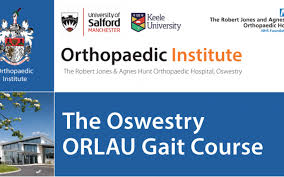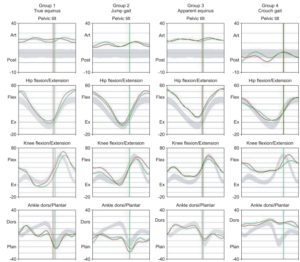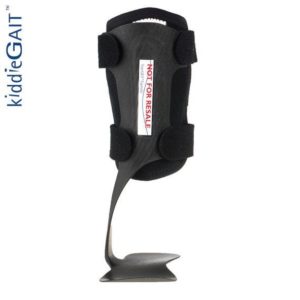
ORLAU Gait Analysis Course
I had a thought provoking, interesting and great time learning and networking on the ORLAU gait analysis course I attended last week.

I have done various gait analysis courses in the past, but this was a really helpful course in revisiting aspects of gait analysis. The course has a high ratio of Faculty experts to participants. This enabled us to work in smaller groups for the mind boggling interpretation of what felt like 100’s of graphs!!
But in reality, once I learnt to look for the simple answer and dust off the (what felt like decrepit) mathematic and physics areas of my brain – which have essentially lay untouched for many years – I surprised myself in being able to actually plot kinematic, kinetic and analyse EMG graphs. Even writing this I’m amazed at how much I learnt on this course.

Sagital plane kinematic dataThe faculty included the great and essentially regal, Mr Andrew Roberts, an expert in ORLAU Gait Analysis, whose presentations were interesting and entertaining on both occasions I have heard him speak – I also now know he DEFINITELY doesn’t come from Dudley! I now better understand the principles behind hamstring length and crouch gait and have learnt a much better way of assessing this more accurately. Amongst other aspects of the clinical examination, as we had several opportunities to revisit examination in practical sessions.
The (not at all forgetful!) Mr Rob Freeman, shared a really interesting case study of a child pre and post SDR, and gave food for thought in terms of therapy input and how orthotic management along with SDR had a huge impact on the child’s gait pattern.
Sarah Jarvis (Physiotherapist) was an excellent Convener (if that’s the right term?!) of the course and entertained my need to discuss lots of the case studies in between the sessions and presented really interesting sessions on Orthotics alongside Tom Woods (Orthotist) and information about other gait analysis outcome measures, if you don’t work in a gait lab.

I revisited concepts that had been buried deeply on engineering concepts on forces, moments and powers, which alongside other topics helped me to understand gait from a different perspective. I better appreciated the forces our muscles have to generate when they have a short lever and how to interpret power and kinematic graphs to identify where there is tension in muscles and therefore aid in the decision making process for management.
Caroline Stewart and Neil Postans (Bioengineers), blew me away with their passion and expert knowledge of the intricacies of gait analysis and their expert delivery, making all aspects interesting and understandable to those of us with limited experience of the workings of a gait lab.
I revisited the gait cycle (many times with the help of Physiotherapist Darren Tinson), who was luckily very patient!! This helped me to look at the gait kinematics and kinetics in different planes and therefore gain a better understanding of all of the components at play and how to simplify and pick out the main limiting factors.
Simon Marchant (Clinical Scientist) managed to entertain the whole group with his theatrical presentation on recognising artefacts – his delivery helped me to remain focussed on a topic that was less relevant for me, but I still really enjoyed.
It was also interesting to go back through the gait cycle with Julie Reay (Physiotherapy Lecturer at Salford), her move from Children’s Community Physiotherapy to her current role is inspiring and it was great to be able to discuss cases with her. I look forward to visiting the Salford gait lab.

My take home lessons, as I mentioned earlier are related to clinical examination, understanding in more depth what effects and contributes to an atypical gait pattern. I am now more aware of the service at ORLAU, which will be of benefit to the children I see in my practice. The case studies and videos in different planes also reinforced my experience of changes in the trunk pre and post SDR and how improving the kinetics in gait enables better activation of lower limb muscles but can also improve the activation of the often underdeveloped abdominal musculature.
All in all, it was a great 3 days, which I would fully recommend. The venue was excellent, along with the provision of lunch and opportunities to network with orthotists, physio’s, consultants and engineers! That doesn’t happen very often in the field of Physiotherapy – but boy when you put those together in a faculty it produces a course of the highest quality.
I was even forgiven for my late application (sorry Sian Jones!). Thank you Sian and Sarah for organising a brilliant course and to the whole faculty for you time and expert knowledge.
I’m looking forward to visiting with my clients and to further my understanding of co-ordination of movement in Cerebral Palsy from the perspective of brain skills, with the observable gait analysis seen on 2 and 3D profiles.
I’ll be back……!
The ORLAU Gait Analysis is one of 26 clinical courses a year, and was organised by the Orthopaedic Institute, a charity at RJAH dedicated to providing funds for Research and Education Orthopaedic Institute. Contact me today to see how I can help your child.